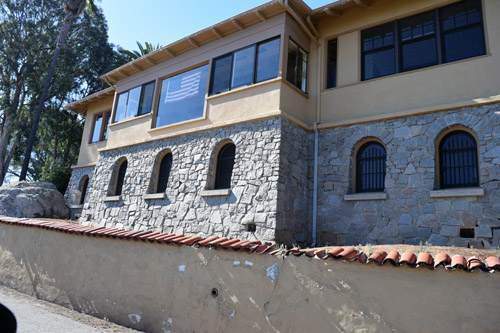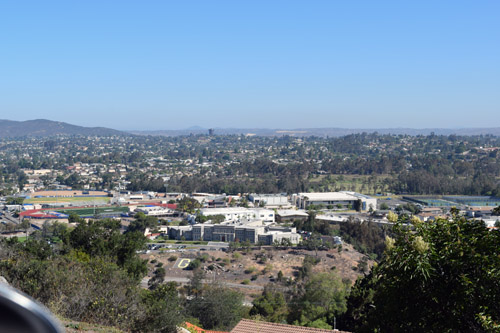
-44th in a Series-
Exit 14C, Fuerte Drive, La Mesa ~ Ernestine Schumann-Heink home
By Donald H. Harrison


LA MESA, California –One climbs the Grossmont—named in the early years of the 20th century by land developer Ed Fletcher for his partner William Gross—up narrow, curving El Granito Avenue, seemingly only big enough for one-way traffic as it twists past giant boulders and trees that Kate Sessions, the horticulturalist who also planted much of Balboa Park, chose to accentuate the views of the El Cajon Valley below.
To this hill of enchantment Gross, who was a theatrical agent, attracted as residents some of the world’s best known musicians, including Ernestine Schumann-Heink, the opera star of her day, who built a large home at 9951 El Granito that still stands today. Schumann-Heink was the Maria Callas, Beverly Sills, Leontyne Price or Roberta Peters of the late 19th and early 20th century, her contralto voice and generosity of spirit loved by almost all.
Born in 1861 to the intermarried couple of Charlotte Goldmann and Hans Rossler, she was Jewish as a matter of halacha, and counted Jewish War Relief among her many charities. But besides for her roles in German and Italian operas, in which she sang duets at the Metropolitan with such co-stars as Enrico Caruso, she also was beloved for singing in English and German each Christmas Eve the classic carol “Silent Night” so beautifully that to hear it annually was said to be an early 20th century tradition.
Stories abounded about Schumann-Heink because in the early 20th century, opera singers were the celebrities of their day; their thoughts, their marriages, their divorces, and their babies—of which Schumann-Heink had seven as well as a step-child who made eight – were a constant source of interest and amusement for newspaper readers.
Schumann-Heink’s mother was a singer who recognized her child’s talent. She arranged for the daughter to study voice with a retired opera singer. When “Tina,” as Ernestine was called, became 21 in she married Ernst Heink, the secretary of the Dresden Opera, where she had performed in small roles. The secretary and singer were fired for breaking the rules against fraternization. On they moved to the Hamburg Opera, where Ernestine continued to sing in small roles until 1889 when the diva Marie Gotze refused to perform after an argument with the opera’s director. Without any rehearsal, Schumann-Heink filled in for her, not only on that day, but for two more days in succession—singing a total of three separate operas. The bravura performances won Schumann-Heink a ten-year contract. In 1893, she and Heink divorced, and she married actor Paul Schumann, who died 11 years later. Her last marriage, which ended in divorce, was to her manager William Rapp, an attorney.
Successful in the opera houses of Europe, Schumann-Heink made her debut at the Metropolitan Opera of New York in 1899, and fell in love with America, a sentiment that was fully returned. In an award-winning article in the Winter 1982 edition of the Journal of San Diego History, Helen Ellsberg wrote:
She owed her great popularity to a phenomenal voice with a range from low D to high C and a magnetic personality that charmed everyone from children to grandparents — that all-important combination of talent and charisma that makes the superstar. She had three husbands and eight children, including a stepson. “Tina” … barely topped five feet in height, but carried herself with such regal dignity that she was occasionally described in the press as looking “tall and stately.” Luminous, dark brown eyes were her loveliest feature. She was widely publicized as a Mother figure. But when, dressed in a silver gown, her white hair shining and her arms and ample bosom ablaze with diamonds, she came across the stage with that radiant smile, she generated her own unique brand of glamor. Her rapport with the audience was established before she ever uttered a note.
Yet, not everyone loved her, certainly not Richard Strauss, who invited her to the Dresden Court Opera House, to sing the part of Klytemnestra in the premiere of the opera Elektra in 1909. According to the oft-told story, Strauss demanded of the orchestra: ““Louder, I can still hear der Heink.”
Kathleen Crawford, in a Fall 1985 article for the Journal of San Diego History, noted that in 1912 Schumann-Heink wrote a letter to describe how excited she was about moving onto Grossmont. “I read so much about ‘Paradise’ well I think I found my dreams realized when I saw Grossmont in our blessed ‘California’ and I am happy as a child in thoughts of my wonderful future home – Casa Ernestina.” A footnote informed readers that “the home of Madame Schumann-Heink included a pantry for a butler, wine cellar, servants’ quarters and a secret room. Inside the walls, interspersed among the boulders, orange, olive, eucalyptus, banana and palm trees grew in profusion.”

Although Schumann-Heink’s hilltop house was large and well furnished, it was not her only residence. She also had a home in Coronado, and she would commute between the two. An indefatigable performer, she also gave concerts and appeared in operas all over the world, giving her little time to actually enjoy the sprawling casa. Rather than the artist colony that Fletcher and Gross had imagined, Grossmont became more of a retreat, or getaway, for the musicians and artists who settled there.
Still, Schumann-Heink developed a special affection for San Diego, and with such local luminaries as John D. Spreckels, Ellen Scripps and George Marston planned to launch an annual outdoor opera festival at Balboa Park’s Organ Pavilion, which she had helped to inaugurate during the Panama-California Exposition of 1915. Generous financial donations were offered in backing for her dream, but before the opening note could be sounded, the United States entered World War I and the idea had to be shelved.
The war was a time of sadness for Schumann-Heink because some of her sons fought in the U.S. military, while another was enrolled in the German military – brothers against brother. She poured her energy into performing for U.S. servicemen and selling war bonds, so excelling in both activities that the soldiers and sailors of America took to calling her “mother.”
After the war, Schumann-Heink moved to Hollywood, but her heart—and ultimately her mortal remains—belonged to San Diego. Following her death in 1935, her ashes were inurned at the Greenwood Cemetery off Imperial Avenue.
*
From Severin/ Fuerte exit turn right onto Severin Drive, which becomes Fuerte, then follow to a left on Sunset, and left again on El Granito
Next: The Mt. Helix cross
*
Harrison is editor of San Diego Jewish World. You may comment to him at donald.harrison@sdjewishworld.com, or post your comment on this website provided that the comment is civil and that you identify yourself by full name and by your city and state of residence.